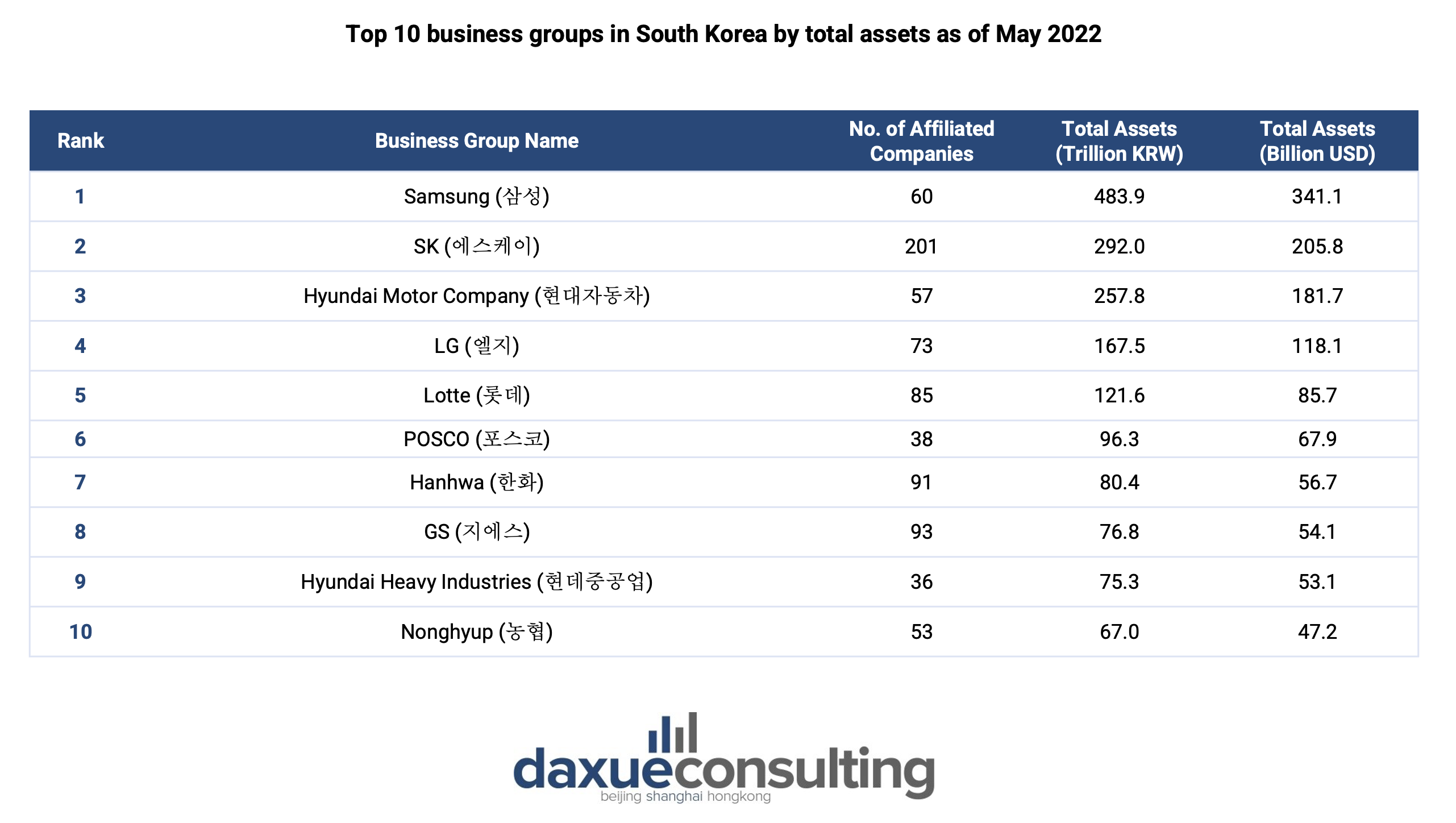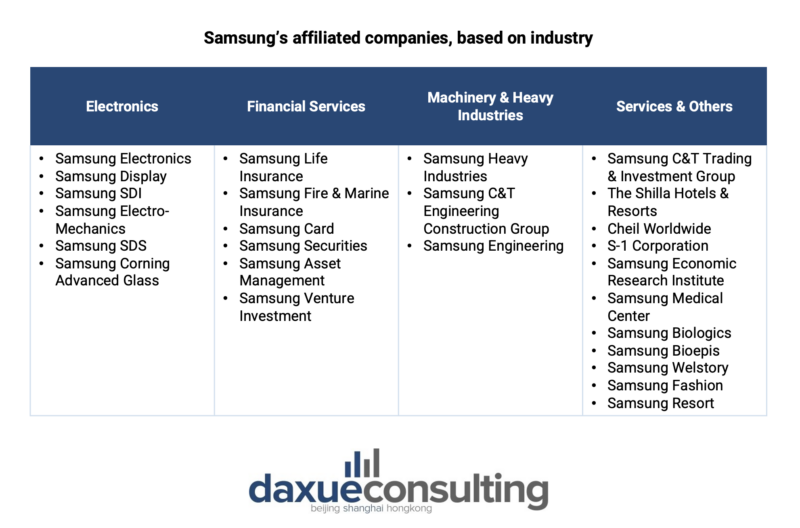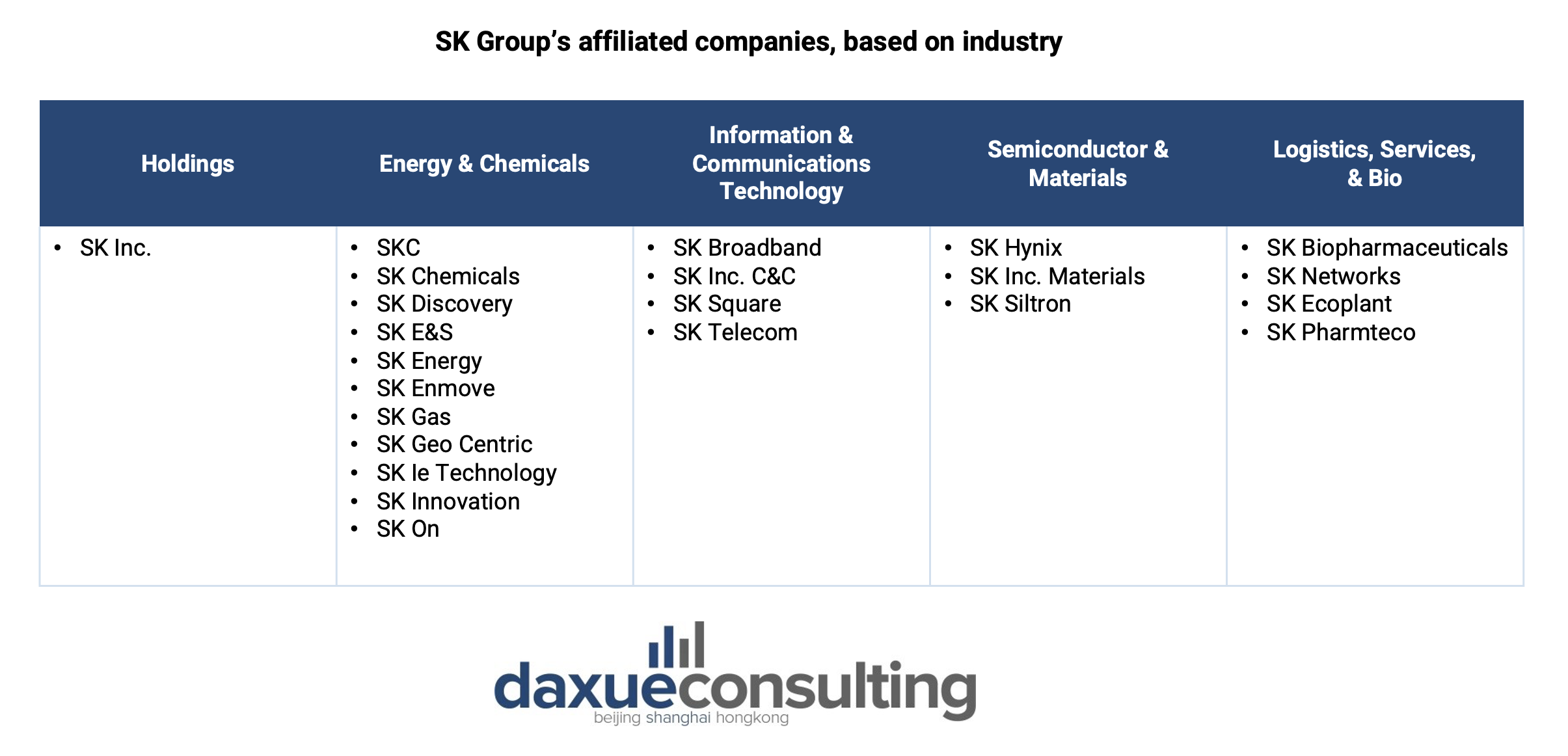When delving into South Korea’s remarkable economic transformation, chaebols (재벌) are a recurring and prominent group of players. South Korean chaebols are large, family-ran business conglomerates that largely dominate the Korean economy. In 2021, the top ten chaebols, including Samsung (삼성), Lotte (롯데), and LG (엘지), collectively contributed nearly 60% to the nation’s GDP. Even during the pandemic, while smaller business struggled to survive, the chaebols showed resilience.
Read our Korea’s MZ Generation report

Introducing the South Korean chaebols: Roots and structure
South Korean chaebols are vital the country’s economy, spanning various industries including manufacturing, finance, and technology. The term chaebol comes from chae (재), meaning wealth, and bol (벌), signifying clan, highlighting their familial and interconnected nature. Family members within this conglomerates hold influential managerial roles, even as the business grows and leadership diversifies.
A historical perspective of chaebols
Chaebols in South Korea have roots in the Japanese occupation of South Korea from 1910 to 1945. Some like Doosan Group draw connections to even earlier periods. The term chaebols and their formation were influenced by Japan’s zaibatsu, family-owned conglomerates. However, in zaibatsu, “family” referred to close bonds, not just blood relations. After World War II, zaibatsu evolved into loose federations of companies, differing from the centralized structure of chaebols.
The chaebols played a pivotal role in South Korea’s economic transformation. In the 1960s, South Korea was considered one of the poorest countries in the world. Its GDP per capita in 1960 was about 160 USD and the country depended on foreign aid. Under the military dictator Park Chung Hee, the country aimed to industrialize and grow into a major economic power. The chaebols maintained economic dominance as the country continued to grow and they received government support. However, the Asian Financial Crisis in 1997 marked a turning point. 16 out of the top 30 chaebols faced bankruptcy due to imprudent diversification. Government interventions like the “Big Deal” forced them to sell non-core businesses, reshaping their strategies and emphasizing core operations.
South Korea’s chaebols: a key force driving the economy
The chaebols are key to the economic growth of Korea, as illustrated by Samsung alone. In 2021, the combined revenue of 15 of Samsung’s affiliated companies accounted for about 20% of the country’s GDP. In 2022, Samsung Electronics Co. contributed KRW 281.4 trillion (USD 216 billion) in social wealth. This involved distributing that wealth to numerous companies and households worldwide. Besides Samsung, SK (에스케이), Hyundai Motor Company (현대자동차), LG (엘지), and Lotte (롯데) are top chaebols in Korea with significant total assets.

A closer look into Korea’s top chaebols: Samsung, SK Telecom, and Hyundai
Samsung and its transition from selling groceries to advanced technologies
Samsung was not always recognized for its technology. Founded in 1938, Samsung started as a grocery trading store by Lee Byung Chul. It mainly traded noodles and other goods in the city of Daegu, nearby areas, and China. Over the years, it diversified into other industries including electronics, machinery and heavy industries, and financial services across numerous countries in the world like the US, China, and Germany. In 2022, Samsung ranked eighth in Forbes’ “world’s most valuable brands”, with a brand value worth USD 50.4 billion and brand revenue of USD 209.5 billion.

SK and its businesses in semiconductors and telecommunications
In 2022, SK ranked up to second place in terms of assets in South Korea for the first time in history since its founding in 1953, surpassing Hyundai Motor Group. It has businesses in semiconductors, energy and chemicals, telecommunications, among others. SK Telecom (에스케이 텔레콤) is widely known in South Korea as one of the largest three Internet service providers in South Korea, after KT (케이티) and LG U+ (엘지 유풀러스). In 2022, more than 43% of mobile phone service users in South Korea were subscribed to SK Telecom as their service provider.

Hyundai’s diverse ventures in South Korea’s economy beyond cars
Hyundai Motor Company, founded in 1967, is known for its leadership in South Korea’s automobile industry. It owns renowned brands like Kia, Hyundai, and Genesis. In September 2022, among the domestic brands, it recorded the largest number of automobile sales. Notably, the top ten cars sold in 2022 were all from Hyundai Motor Group, underscoring the company’s dominance in the market with nearly 40% market share.
Hyundai Motor Company has also diversified into finance, IT/software, and logistics sectors. One of its businesses is Hyundai Card (현대카드), a leading credit card company in South Korea. In a significant move, it formed a partnership with Apple Pay, leading to Apple Pay’s entry into the South Korean market in March 2023. This strategic move garnered substantial attention from the younger demographic in Korea and exerted pressure on Samsung Electronics within the mobile payment market.
The chaebol paradox: Driving economic progress or posing social challenges?
While chaebols have played a crucial role South Korea’s economic development, they have also contributed to economic and social challenges, such as youth unemployment, wage inequality, and limited entrepreneurship opportunities. The influence of chaebols also extends to education, perpetuating an intense competition for jobs at these corporations. Additionally, skyrocketing real estate prices, influenced by chaebols’ involvement in construction and land speculation, have widened the wealth gap and hindered social mobility. Chaebols also pose a threat to South Korea’s democracy due to their lobbying power and involvement in corruption scandals.
With increasing public discontent, comparisons have been drawn between chaebols in South Korea and Japan’s zaibatsu, which were dismantled after the World War 2. This has raised questions about the future of these conglomerates. However, the pace of chaebol reforms has been slow and ineffective. Efforts at reform, such as promoting the growth of start-ups, have not significantly reduced the chaebols’ influence. There is a concern that without these conglomerates, South Korea might struggle to compete internationally. The chaebols represent more than just economic entities; they symbolize South Korea’s pride and global standing. The challenge lies not only in dismantling these conglomerates but also in overcoming the deeply rooted cultural and societal ties that connect them to the nation’s identity.
Chaebols in South Korea: Shaping the economy and society
- Chaebols are large family-controlled conglomerates who have significant economic power in South Korea. The top ten collectively contributed to 60% of the the country’s GDP in 2021.
- Samsung, SK, and Hyundai Motors are the top chaebols in South Korea. They have existed since the 1900s and have remained in powerful positions today.
- These chaebols have diversified across industries, from technology and semiconductors to automobile and logistics.
- Despite economic contributions, chaebols have contributed to issues including youth unemployment, wage disparity, and limited entrepreneurship opportunities. Reforms to curb chaebol influence have been slow and ineffective.






